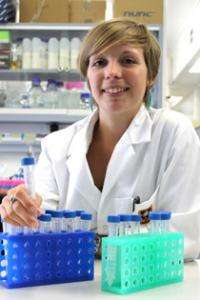Researchers create billion-year-old bacteria and trace its evolution

(�鶹��ԺOrg.com) -- University of Waikato researchers have managed to create a billion-year-old bacterial enzyme and then trace its evolution through history, to the modern day.
Associate Professor Vic Arcus and postdoctoral research scientist Dr. Jo Hobbs have used new computational techniques to make accurate predictions about the size, shape and composition of proteins from ancient bacteria.
They then coaxed modern bacteria into making these ancient proteins for them, creating a billion-year-old Bacillus bacteria enzyme.
“We’ve been able to make a billion-year-old protein enzyme that actually works in the lab,” says researcher Jo Hobbs.
“The billion-year-old enzyme is from a Precambrian ancestor of a modern bacterium called Bacillus,” explains Dr. Arcus.
“To our surprise, the ancient enzyme is very stable at high temperatures and very, very active - seven times more active than a comparable modern enzyme.”
“This means that the Bacillus ancestor most probably lived in a hot, inhospitable environment a billion years ago.”
Tracing Evolution
Along with the billion-year-old enzyme, the team created enzymes that trace the evolution of the organisms from one billion years ago to the present day.
They tested the optimal operating temperature of each enzyme to get an insight into the changing temperate of the environment of the bacteria over time.
“The optimum temperature of the billion-year-old organism is 70 degrees. But during the evolution of these bacteria, they have adapted to cooling temperatures. Today we find Bacillus bacteria in nearly every possible environment – hot pools, garden soil, cool lakes, even in Antarctica,” says Dr Arcus.
“They are the weeds of the bacterial world. Their ability to adapt to a great range of different environments over such long periods of time has been their success on planet Earth.”
The team have had their findings published in the Journal of Molecular Biology and Evolution.
Provided by University of Waikato


















